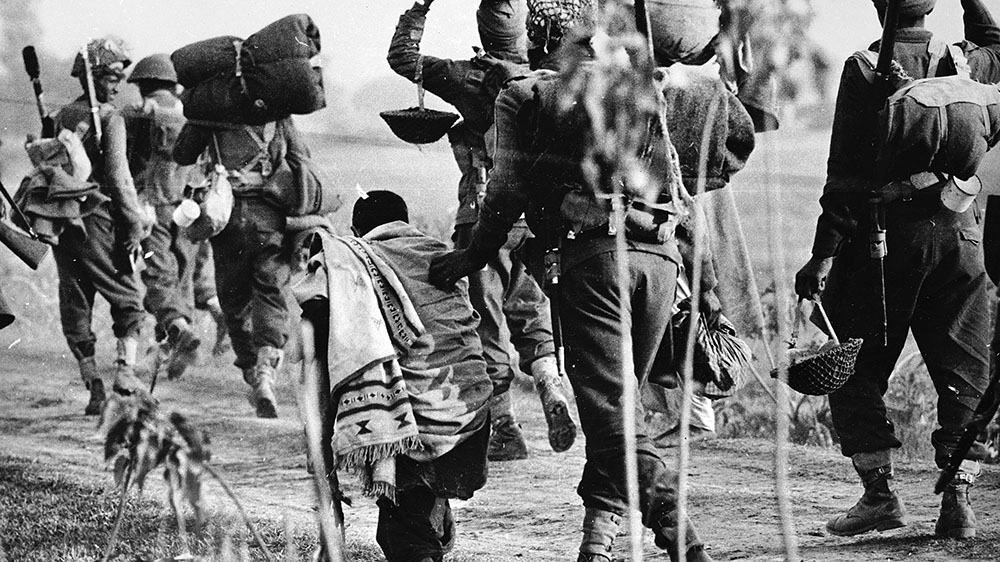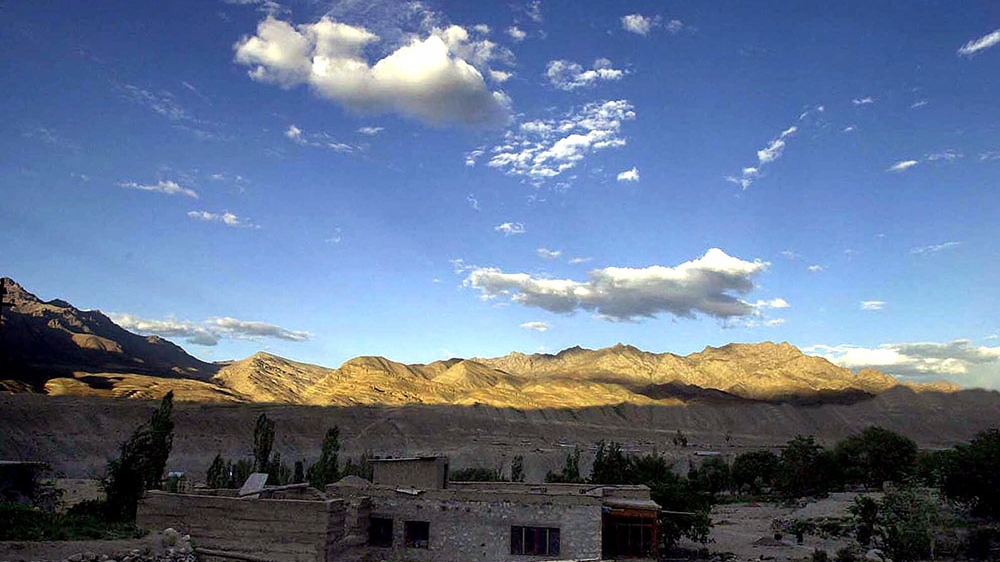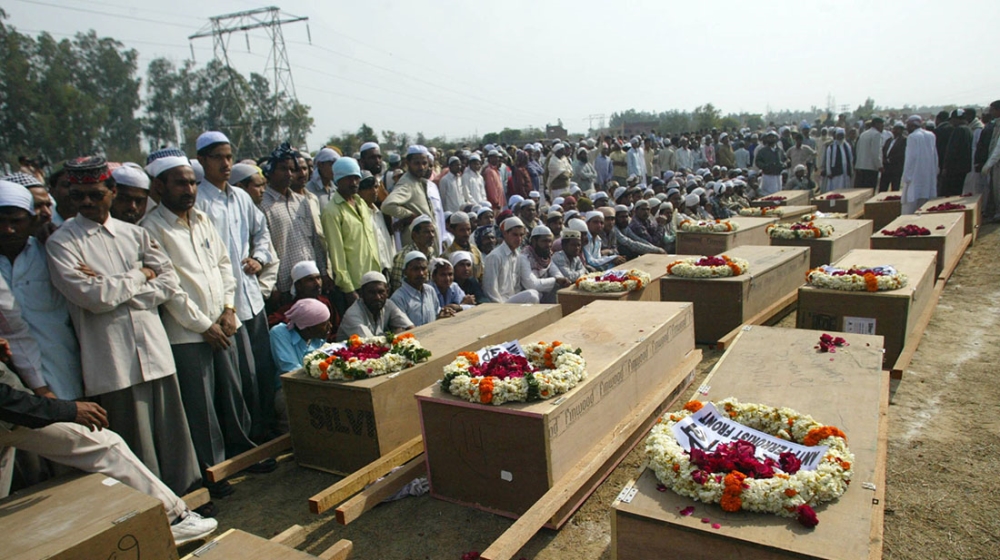1947 – Britain, as part of its pullout from the Indian subcontinent, divides it into secular (but mainly Hindu) India and Muslim Pakistan on August 15 and 14 respectively. The partition causes one of the largest human migrations ever seen and sparks riots and violence across the region.
1947/48 – The first India-Pakistan war over Kashmir is fought, after armed tribesmen (lashkars) from Pakistan’s North-West Frontier Province (now called Khyber-Pakhtunkhwa) invade the disputed territory in October 1947. The Maharaja, faced with an internal revolt as well an external invasion, requests the assistance of the Indian armed forces, in return for acceding to India. He hands over control of his defence, communications and foreign affairs to the Indian government.
 |
| Maharaja of Kashmir, June 20, 1946 [File: The Associated Press] |
Both sides agree that the instrument of accession signed by Maharaja Hari Singh be ratified by a referendum, to be held after hostilities have ceased. Historians on either side of the dispute remain undecided as to whether the Maharaja signed the document after Indian troops had entered Kashmir (i.e. under duress) or if he did so under no direct military pressure.
Fighting continues through the second half of 1948, with the regular Pakistani army called upon to protect Pakistan’s borders.
The war officially ends on January 1, 1949, when the United Nations arranges a ceasefire, with an established ceasefire line, a UN peacekeeping force and a recommendation that the referendum on the accession of Kashmir to India be held as agreed earlier. That referendum has yet to be held.
Pakistan controls roughly one-third of the state, referring to it as Azad (free) Kashmir. It is semi-autonomous. A larger area, including the former kingdoms of Hunza and Nagar, is controlled directly by the central Pakistani government.
The Indian (eastern) side of the ceasefire line is referred to as Jammu and Kashmir state.
Both countries refer to the other side of the ceasefire line as “occupied” territory.
1954 – The accession of Jammu and Kashmir to India is ratified by the state’s constituent assembly.
1957 – The Jammu and Kashmir constituent assembly approves a constitution. India, from the point of the 1954 ratification and 1957 constitution, begins to refer to Jammu and Kashmir as an integral part of the Indian union.
1963 – Following the 1962 Sino-Indian war, the foreign ministers of India and Pakistan – Swaran Singh and Zulfiqar Ali Bhutto – hold talks under the auspices of the British and Americans regarding the Kashmir dispute. The specific contents of those talks have not yet been declassified, but no agreement was reached. In the talks, “Pakistan signified willingness to consider approaches other than a plebiscite and India recognised that the status of Kashmir was in dispute and territorial adjustments might be necessary,” according to a declassified US state department memo (dated January 27, 1964).
1964 – Following the failure of the 1963 talks, Pakistan refers the Kashmir case to the UN Security Council.
 |
| Army general J N Chaudhuri and Air Marshal Arjan Singh at the Defence Headquarters in New Delhi after the cease-fire following the second India-Pakistan conflict in 1965. [Photo by Keystone/Getty Images] |
1965 – India and Pakistan fight their second war. The conflict begins after a clash between border patrols in April in the Rann of Kutch (in the Indian state of Gujarat), but escalates on August 5, when between 26,000 and 33,000 Pakistani soldiers cross the ceasefire line dressed as Kashmiri locals, crossing into Indian-administered Kashmir.
Infantry, armour and air force units are involved in the conflict while it remains localised to the Kashmir theatre, but as the war expands, Indian troops cross the international border at Lahore on September 6. The largest engagement of the war takes place in the Sialkot sector, where between 400 and 600 tanks square off in an inconclusive battle.
By September 22, both sides agree to a UN-mandated ceasefire, ending the war that had by that point reached a stalemate, with both sides holding some of the other’s territory.
1966 – On January 10, 1966, Indian Prime Minister Lal Bahadur Shastri and Pakistani President Ayub Khan sign an agreement at Tashkent (now in Uzbekistan), agreeing to withdraw to pre-August lines and that economic and diplomatic relations would be restored.
 |
| An elderly Pakistani refugee is pushed aside by Indian troops advancing into the East Pakistan (Bangladesh) area during the 1971 Indo-Pakistani war. [Getty Images] |
1971 – India and Pakistan go to war a third time, this time over East Pakistan. The conflict begins when the central Pakistani government in West Pakistan, led by Zulfiqar Ali Bhutto, refuses to allow Awami League leader Sheikh Mujibur Rahman, a Bengali whose party won the majority of seats in the 1970 parliamentary elections, to assume the premiership.
A Pakistani military crackdown on Dhaka begins in March, but India becomes involved in the conflict in
December, after the Pakistani air force launches a pre-emptive attack on airfields in India’s northwest.
India then launches a coordinated land, air and sea assault on East Pakistan. The Pakistani army surrenders at Dhaka, and its army of more than 90,000 become prisoners of war. Hostilities lasted 13 days, making this one of the shortest wars in modern history.
East Pakistan becomes the independent country of Bangladesh on December 6, 1971.
 |
| Indian Prime Minister Indira Gandhi, right, and President of Pakistan Zulfikar Ali Bhutto shake hands after signing and agreement in the Governor’s Mansion, in Simla on June 28, 1972. [The Associated Press] |
1972 – Pakistani Prime Minister Zulfikar Ali Bhutto and Indian Prime Minister Indira Gandhi sign an agreement in the Indian town of Simla, in which both countries agree to “put an end to the conflict and confrontation that have hitherto marred their relations and work for the promotion of a friendly and harmonious relationship and the establishment of a durable peace in the subcontinent”. Both sides agree to settle any disputes “by peaceful means”.
The Simla Agreement designates the ceasefire line of December 17, 1971, as being the new “Line-of-Control (LoC)” between the two countries, which neither side is to seek to alter unilaterally, and which “shall be respected by both sides without prejudice to the recognised position of either side”.
1974 – The Kashmiri state government affirms that the state “is a constituent unit of the Union of India”. Pakistan rejects the accord with the Indian government.
On May 18, India detonates a nuclear device at Pokhran, in an operation codenamed “Smiling Buddha”. India refers to the device as a “peaceful nuclear explosive”.
1988 – The two countries sign an agreement that neither side will attack the other’s nuclear installations or facilities. These include “nuclear power and research reactors, fuel fabrication, uranium enrichment, isotopes separation and reprocessing facilities as well as any other installations with fresh or irradiated nuclear fuel and materials in any form and establishments storing significant quantities of radio-active materials”.
Both sides agree to share information on the latitudes and longitudes of all nuclear installations. This agreement is later ratified, and the two countries share information on January 1 each year since then.
1989 – Armed resistance to Indian rule in the Kashmir valley begins. Muslim political parties, after accusing the state government of rigging the 1987 state legislative elections, form activist wings.
Pakistan says that it gives its “moral and diplomatic” support to the movement, reiterating its call for the earlier UN-sponsored referendum.
India says that Pakistan is supporting the resistance by providing weapons and training to fighters, terming attacks against it in Kashmir “cross-border terrorism”. Pakistan denies this.
Activist groups taking part in the fight in Kashmir continue to emerge through the 1990s, in part fuelled by a large influx of “mujahideen” who took part in the Afghan war against the Soviets in the 1980s.
1991 – The two countries sign agreements on providing advance notification of military exercises, manoeuvres and troop movements, as well as on preventing airspace violations and establishing overflight rules.
1992 – A joint declaration prohibiting the use of chemical weapons is signed in New Delhi.
 |
| May 23, 1996 – Kashmiri protesters flee from Indian security forces after their procession, held against the first parliamentary elections held in much of Kashmir valley, was broken up in Baramulla, India-administered Kashmir. [John Moore/The Associated Press] |
1996 – Following a series of clashes, military officers from both countries meet at the LoC in order to ease tensions.
1998 – India detonates five nuclear devices at Pokhran. Pakistan responds by detonating six nuclear devices of its own in the Chaghai Hills. The tests result in international sanctions being placed on both countries. In the same year, both countries carry out tests of long-range missiles.
1999 – Indian Prime Minister Atal Bihari Vajpayee meets with Nawaz Sharif, his Pakistani counterpart, in Lahore. The two sign the Lahore Declaration, the first major agreement between the two countries since the 1972 Simla Accord. Both countries reaffirm their commitment to the Simla Accord, and agree to undertake a number of ‘Confidence Building Measures’ (CBMs).
Some of the diplomatic gains are eroded, however, after the Kargil conflict breaks out in May. Pakistani forces and Kashmiri fighters occupy strategic positions on the Indian side of the LoC, prompting an Indian counter-offensive in which they are pushed back to the other side of the original LoC.
 |
| The view of the frontier from the border town of Kargil in Indian-administered Kashmir. [Aijaz Rahi/The Associated Press] |
Kargil is the first armed conflict between the two neighbours since they officially conducted nuclear weapons tests.
In October 1999, General Pervez Musharraf, the Pakistani chief of army staff, leads a military coup, deposing Nawaz Sharif, the then prime minister, and installing himself as the head of the government.
2001 – Tensions along the Line of Control remain high, with 38 people killed in an attack on the Kashmiri assembly in Srinagar. Following that attack, Farooq Abdullah, the chief minister of Indian-administered Kashmir, calls on the Indian government to launch a full-scale military operation against alleged training camps in Pakistan.
 |
| Pakistani President General Pervez Musharraf, left, is greeted by Indian Prime Minister Atal Bihari Vajpayee at the Presidential Palace in New Delhi on July 14, 2001. [Ajit Kumar/The Associated Press] |
In July, Pakistani President Pervez Musharraf and Indian Prime Minister Atal Behari Vajpayee meet for a two-day summit in the Indian city of Agra. That summit collapses after two days, with both sides unable to reach agreement on the core issue of Kashmir.
On December 13, an armed attack on the Indian parliament in New Delhi leaves 14 people dead. India blames Lashkar-e-Taiba and Jaish-e-Muhammad for the attacks.
The attacks lead to a massing of India’s and Pakistan’s militaries along the LoC. The standoff only ends in October 2002, after international mediation.
2002 – President Musharraf pledges that Pakistan will combat extremism on its own soil, but affirms that the country has a right to Kashmir.
2003 – After Musharraf calls for a ceasefire along the LoC during a UN General Assembly meeting in September, the two countries reach an agreement to cool tensions and cease hostilities across the de facto border.
2004 – Vajpayee and Musharraf hold direct talks at the 12th SAARC summit in Islamabad in January, and the two countries’ foreign secretaries meet later in the year. This year marks the beginning of the Composite Dialogue Process, in which bilateral meetings are held between officials at various levels of government (including foreign ministers, foreign secretaries, military officers, border security officials, anti-narcotics officials and nuclear experts). In November, on the eve of a visit to Indian-administered Kashmir, the new Indian prime minister, Manmohan Singh, announces that India will be reducing its deployment of troops there.
2006 – India redeploys 5,000 troops from Jammu and Kashmir, citing an “improvement” in the situation there, but the two countries are unable to reach an agreement on withdrawing forces from the Siachen glacier.
In September, President Musharraf and Prime Minister Singh agree to put into place an India-Pakistan institutional anti-terrorism mechanism.
 |
| People look on at the mass burial of the unidentified bodies of the victims of Samjhauta Express Train attack in Panipat, India. [Mustafa Quraishi/The Associated Press] |
2007 – On February 18, the train service between India and Pakistan (the Samjhauta Express) is bombed near Panipat, north of New Delhi. Sixty-eight people are killed, and dozens injured.
The fifth round of talks regarding the review of nuclear and ballistic missile-related CBMs is held as part of the Composite Dialogue Process. The second round of the Joint Anti-Terrorism Mechanism (JATM) is also held.
2008 – India joins a framework agreement between Turkmenistan, Afghanistan and Pakistan on a $7.6bn gas pipeline project. A series of Kashmir-specific CBMs are also agreed to (including the approval of a triple-entry permit facility).
In July, India blames Pakistan’s Inter-Services Intelligence (ISI) directorate for a bomb attack on the Indian embassy in Kabul, which kills 58 and injures another 141.
In September, Pakistani President Asif Ali Zardari and Indian Prime Minister Singh formally announce the opening of several trade routes between the two countries.
In October, cross-LoC trade commences, though it is limited to 21 items and can take place on only two days a week.
 |
| An Indian soldier takes cover as the Taj Mahal hotel burns during gun battle between Indian military and rebels inside the hotel in Mumbai, India. [David Guttenfelder, File/The Associated Press] |
On November 26, armed gunmen open fire on civilians at several sites in Mumbai, India. The attacks on the Taj Mahal Palace & Tower, the Oberoi Trident Hotel, the Chhatrapati Shivaji Terminus, Leopold Cafe, Cama Hospital, Nariman House Jewish community centre, Metro Cinema, St Xavier’s College and in a lane near the Times of India office, prompt an almost three-day siege of the Taj, where gunmen remain holed up until all but one of them are killed in an Indian security forces operation. More than 160 people are killed in the attacks.
Ajmal Kasab, the only attacker captured alive, says the attackers were members of Lashkar-e-Taiba.
In the wake of the attacks, India breaks off talks with Pakistan.
2009 – The Pakistani government admits that the Mumbai attacks may have been partly planned on Pakistani soil, while vigorously denying allegations that the plotters were sanctioned or aided by Pakistan’s intelligence agencies.
Pakistani Prime Minister Yousaf Raza Gilani and Indian Prime Minister Singh meet on the sidelines of a Non-Aligned Movement (NAM) summit in Sharm el-Sheikh, Egypt, issuing a joint statement charting future talks. Singh rules out, however, the resumption of the Composite Dialogue Process at the present time.
The Indian government continues to take a stern line with Pakistan, however, with its coalition government saying that it is up to Pakistan to take the first step towards the resumption of substantive talks by cracking down on activist groups on its soil.
In August, India gives Pakistan a new dossier of evidence regarding the Mumbai attacks, asking it to prosecute Hafiz Mohammad Saeed, the head of Jamaat-ud-Dawa, an Islamic charity with ties to Lashkar-e-Taiba.
2010 – In January, Pakistani and Indian forces exchange fire across the LoC in Kashmir, the latest in a string of such incidents that have led to rising tension in the area.
In February, India and Pakistan’s foreign secretaries meet in New Delhi for talks. This meeting is followed by the two countries’ foreign ministers meeting in Islamabad in July.
 |
| People watch television shows a news report about Mumbai attacks suspect Mohammed Ajmal Kasab in Karachi, Pakistan on May 6, 2010. [Fareed Khan/The Associated Press] |
In May, Ajmal Kasab is found guilty of murder, conspiracy and of waging war against India in the Mumbai attacks case. He is sentenced to death.
2011 – In January, Indian Home Secretary GK Pillai says India will share information with Pakistan regarding the 2001 Samjhauta Express bombing. The two countries’ foreign secretaries meet in Thimpu, Bhutan, in February, and agree to resume peace talks “on all issues”.
2012 – In November, India executes Pakistani national Kasab, the lone survivor of a fighter squad that killed 166 people in a rampage through the financial capital Mumbai in 2008, hanging him just days before the fourth anniversary of the attack.
2013 – In January, India and Pakistan trade accusations of violating the ceasefire in Kashmir, with Islamabad accusing Indian troops of a cross-border raid that killed a soldier and India charging that Pakistani shelling destroyed a home on its side.
2013 – In September, the prime ministers of India and Pakistan meet in New York on the sidelines of the UN General Assembly. Both the leaders agree to end tension between armies of both sides in the disputed Kashmir.
2014 – On February 12, India and Pakistan agree to release trucks held in their respective territories, ending a three-week impasse triggered by the seizure of a truck in India-administered Kashmir coming from across the de facto Line of Control for allegedly carrying brown sugar.
2014 – On May 1, Pakistan’s Army chief General Raheel Sharif calls Kashmir the “jugular vein” of Pakistan, and that the dispute should be resolved in accordance with the wishes and aspirations of Kashmiris and in line with UNSC resolutions for lasting peace in the region.
2014 – On May 25, Pakistan releases 151 Indian fishermen from its jails in a goodwill gesture ahead of the swearing-in ceremony of Narendra Modi as prime minister.
2014 – On May 27, Indian Prime Minister Narendra Modi holds talks with Pakistan’s Prime Minister Nawaz Sharif in New Delhi. Both sides express willingness to begin a new era of bilateral relations.
2015 – Modi makes a surprise visit to the Pakistani eastern city of Lahore on Sharif’s birthday and the wedding of his grand-daughter.
2016 – India launches what it calls “surgical strikes” on “terrorist units” in Pakistan-administered Kashmir in September, less than two weeks after an attack on an Indian army base leaves 19 soldiers dead. Pakistan denies the attacks took place.
In November, seven Indian soldiers are killed after rebels disguised as policemen storm a major army base near the frontier with Pakistan.
2019 – In the early hours of February 26, India conducts air attacks against what it calls Pakistan-based rebel group Jaish-e-Mohammad (JeM)’s “biggest training camp”, killing “a very large number of terrorists”.
